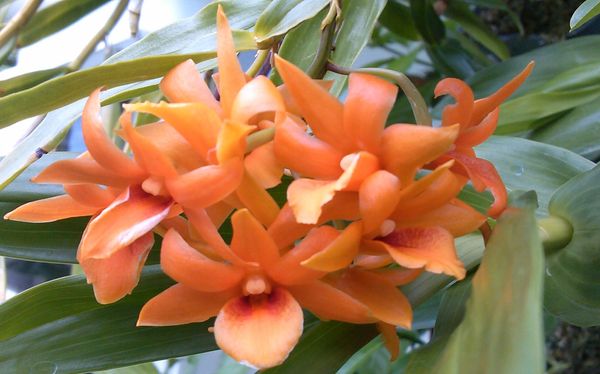
Calcarifera section
Cultural Information
SPECIES:
This group has got to be one of the most rewarding and wonderful sections for me to grow. Some have proved challenging to grow, to say the least, but the rewards in the end have far surpassed the challenges.
Many people have seen amethystoglossum in collections and at orchid shows. It can definitely be grown the same way as other typical or hard cane Dendrobiums. Canes bloom very well once the plant is established and happy, often producing big shows of flowers.
My crocatum is one that really surprised me. While it took the plant about 2 years to get established, once it started blooming, the plan produced flowers from late March pretty constantly and consistently through until the beginning of November.
As for victoriae-reginae, it was difficult at first until I started digging around and getting some clues together. I knew someone when I lived in Pennsylvania who had a rather large specimen. He had it potted in a bark mix and told me that it took him a while to get it established. Once it was in the new mix for several months, it would start to grow better. On the surface of his bark mix I noticed some moss growing on the bark.
Now living in south Florida, I don't use bark, charcoal, or bark mixes at all due to snow mold, but I decided to try it in this case just to try. Unfortunately, it didn't work and the plant died within a year. Everyone told me that victoriae-reginae grew cold and I would not be able to grow it here. However, I know that the plant can be found growing in some areas at about 450 meters which is at the hot/warm area. So I knew there had to be something else to it. Doing some more research, I kept reading that the plants, no matter the elevation, seemed to be growing on the north sides of trees with their roots in the live moss growing on their host trees. I remembered back to my friend growing his plant and remembered that his plant did not do well for months after repotting. Then I remembered, the moss.
Was it possible that this plant has some kind of symbiosis with the live moss? So I did an experiment. I bout three plants. One plant I potted in a plastic Vanda basket with sphagnum moss; one plant in a pot with a mix of sphagnum moss, Aliflor and sponge rock; and the third plant I also potted in a plastic Vanda basket with sphagnum moss, but in this one, I took a few pieces of live moss from one of my bonsai and placed it into the sphagnum moss. Within a couple of months the plant with the live moss took off, as did the live moss, the other two plants started to decline. Before the other two completely died off, I added some live moss to the top of the pot and basket and once the moss started to grow, the plants came back and started to thrive. Now, I'm not sure if the live moss just keeps the roots moist, cool, or if there's something nutritionally supplemented, but there definitely is some benefit, at least in the heat. Plants bloom sporadically year round with a larger flush of flowers in the spring. For those who don't wish to try the species, or can't find it, the hybrid Dendrobium Kuniko (miyakei x victoriae-reginae) is a very good and prolific hybrid that does very well in the heat as well as in cooler temperatures.
Potting or Mounting: These plants require plenty of water during their active growing period. Use a pot that seems too small for the plant or a plastic Vanda basket with sphagnum moss making sure that the sphagnum moss dries out to a "damp dry" state before watering again. These plants like air movement around the roots for the most part which is why when I use sphagnum moss, I use a Vanda basket, or net basket. Mounting works on some of the smaller species, though the larger ones might not work as well mounted.
Light: Light can vary from species to species but I make sure to give them all a couple of hours of early morning direct sun at the least. Den. victoriae-reginae does well in light a bit brighter than Phalaenopsis, whereas my amethystoglossum, annae, and crocatum get a few hours of direct sun every day.
Water: Plants from this section tend to like pretty consistent water throughout the year with only a very slight reduction of water in the winter time.
Fertilizer: use a balanced fertilizer for most of the year reducing in the winter months.
Section Descriptions
Pictured above - Dendrobium crocatum.
Section Calcarifera is characterized by verrucose roots, slim to fusiform stems which are often pendulous containing many leaves all along the stems. Leaves are semideciduous and often completely drop off by their second or third year. Flowers bloom on numerous, short, lateral, pendent racemes on both the newer stems and older leafless stems. The flowers pedicel is inserted at a right angle to the mentum.
This section is very similar to section Pedilonium but it is this final item of morphology is the best way of distinguishing between the two sections.
Commonly grown species are: amethystoglossum, annae, boosii, ceraula, crocatum, serratilabium, and victoriae-reginae
Photo Gallery

Den crocatum

Den. amethysteglossum

Den. annae

Den. victoriae-reginae

Den. Kuniko